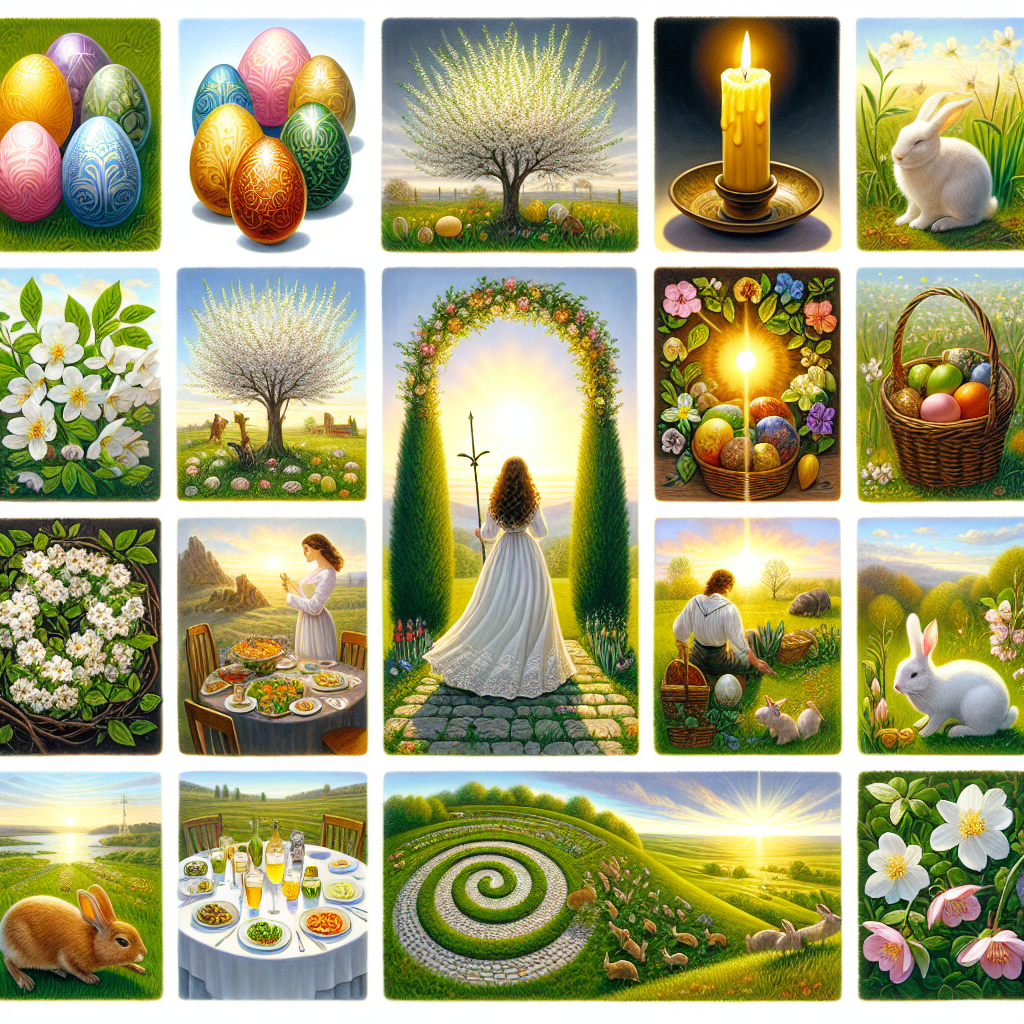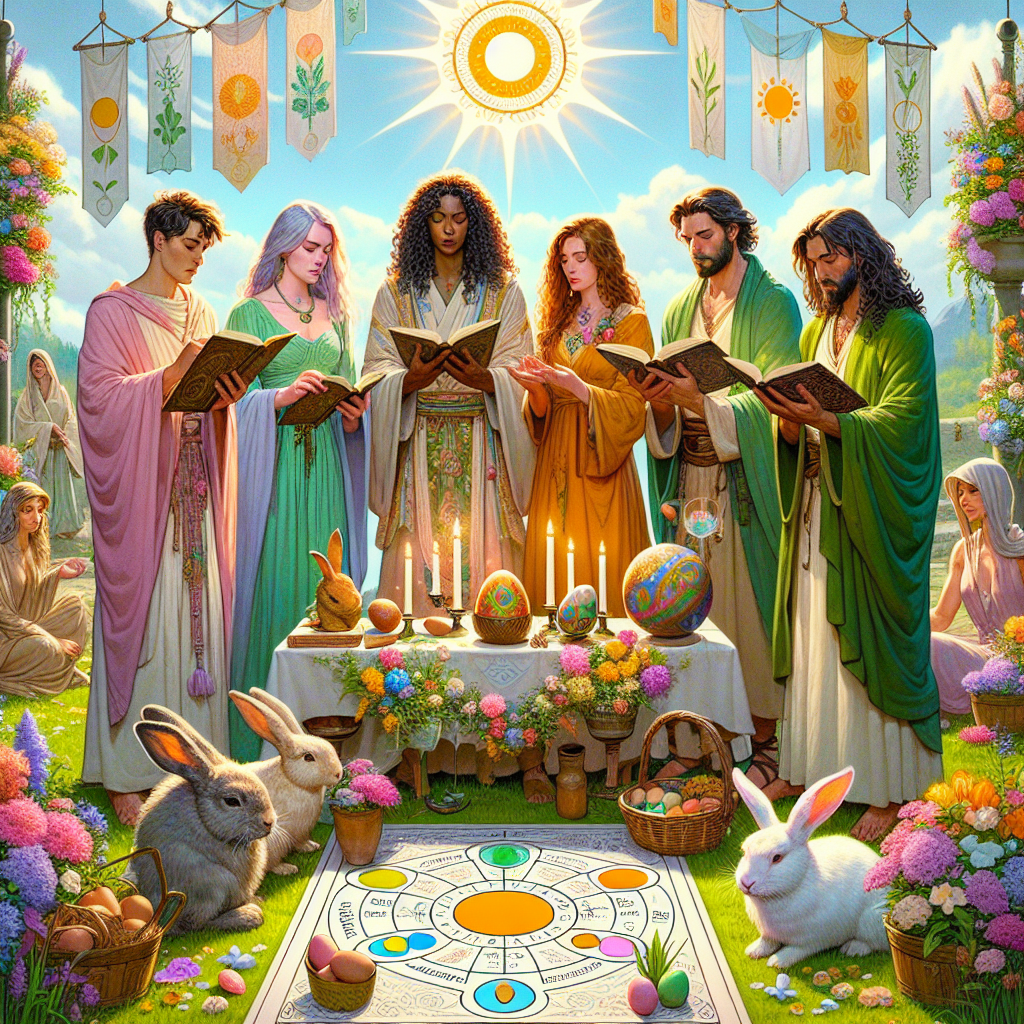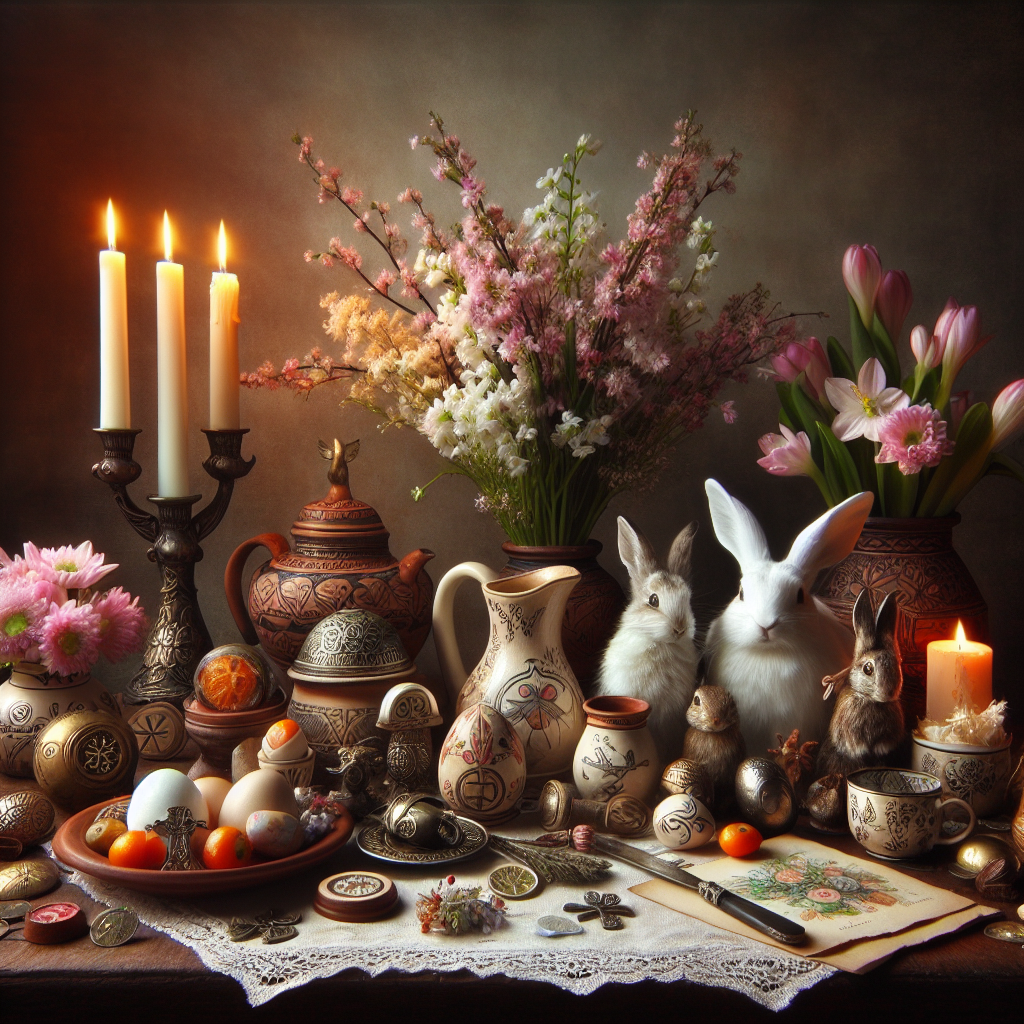As an Amazon Associate I earn from qualifying purchases.

Attention-Grabbing Fact and Introduction
Ostara, frequently acknowledged as the Spring Equinox, represents a critical juncture in pagan traditions, marking the equilibrium between light and darkness. Named after the Germanic goddess Eostre, this festival celebrates rebirth, fertility, and renewal. Currently, it bears significance not only for its cultural heritage but also for those seeking to reconnect with nature, reflecting a growing trend in modern spirituality. Interestingly, the celebration of Ostara has seen a 30% increase in interest over the past decade, indicating its rising prominence in contemporary society.
On Decorating and Setting the Mood
Decorating your space with symbols of spring creates an environment ripe for Ostara celebrations. Incorporate floral arrangements, pastel colors, and symbols like eggs and rabbits to evoke the spirit of renewal. This ambiance aids in aligning your surroundings with the festive energy.
To further set the mood, lighting candles in green and yellow can invigorate your space. Their warm glow evokes the lengthening days, enhancing the sense of balance that Ostara embodies. Aromatic herbs like lavender and chamomile may be burned for their soothing effects, providing a tranquil atmosphere conducive to reflection and celebration.
Engaging Activities for All Ages
One engaging way to celebrate Ostara is through planting seeds, literally sowing the growth and potential heralded by the equinox. This activity is particularly rewarding for families, as it involves all ages in nurturing and witnessing the growth process firsthand, reinforcing the themes of rebirth and renewal.
Another charming practice is crafting and decorating eggs, echoing the ancient symbols of fertility and new beginnings. This creative endeavor can be both fun and meditative, offering a hands-on method to honor Ostara's themes.
Feasting and Culinary Traditions
Feasting on seasonal and locally-sourced foods connects celebrants with the earth’s cycles, a core principle of Ostara. Early spring greens, nuts, seeds, and dairy products often feature prominently in traditional menus, reflecting nature's bounty during this time of rejuvenation.
Baking special bread or cakes that incorporate seeds or honey serves as both a festive activity and a ritualistic offering. Such culinary traditions provide a tangible way to imbue your celebration with meaning, offering sustenance that is symbolic and nourishing.
Spiritual Practices and Rituals
Building an altar is a powerful spiritual practice for Ostara. Decorate it with representations of earth, air, fire, and water, alongside symbols of fertility like flowers, seeds, and statues of hares or eggs. This sacred space can serve as a focal point for meditation and rituals during the equinox.
Engaging in a cleansing ritual by sweeping your space with a broom or besom, symbolic of brushing away the old to welcome the new, embodies the essence of renewal. This act purifies both the physical realm and the spirit, aligned with the equinox's balancing energies.
1. **Create an Ostara Altar**: Set up an altar for Ostara, the spring equinox, adorned with symbols of spring like flowers, eggs, seeds, and pastel colors. This altar serves as a focal point for your spring rituals, enhancing the energy of renewal and rebirth which Ostara celebrates.
2. **Plant Seeds**: One of the most potent forms of Ostara magic is planting seeds. It represents new beginnings and growth. Choose native plants or ones that embody qualities you wish to cultivate in your life. This activity helps bridge the physical and metaphysical, nurturing both plants and your personal intentions.
3. **Egg Decorating**: Decorated eggs are traditional Ostara symbols. Use natural dyes from vegetables or herbs for an eco-friendly touch. This practice can be a family activity or a solitary ritual, infusing your decorations with personal symbols and intentions for the coming season.
4. **Spring Cleaning**: Engage in a thorough spring cleaning ritual. This activity can be both literal and spiritual, cleansing your living space and removing any stagnant energy accumulated over the winter. Infuse your cleaning products with essential oils like lavender or lemon for added refreshment and purification.
5. **Nature Walks and Outdoor Meditations**: Connect with the burgeoning energy of spring by taking nature walks or meditating outdoors. Focus on the new growth around you, and let it inspire your inner growth. This is an excellent way to ground yourself and absorb the equinox magic present in the natural world.
6. **Seasonal Spells for Growth**: Perform spells aimed at personal or spiritual growth. Use candles, herbs, and crystals that correspond to rebirth and renewal, such as green calcite, dandelion, and sunflowers. These elements will amplify your intentions during your spring witchcraft practice.
7. **Host a Feasting Celebration**: Gather friends and family for a feast featuring seasonal foods like fresh greens, eggs, and lamb. Sharing a meal during Ostara, a cornerstone of witchcraft holidays, fortifies communal bonds and celebrates abundance.
8. **Craft Ostara Wreaths**: Create a wreath using spring flowers, twigs, and ribbons in pastel or earthy tones. Hang it on your door as a symbol of welcome and renewal, invoking the positive energy of the season every time you enter your home.
9. **Make an Equinox Intention Jar**: Write down your goals and intentions for the upcoming months and place them in a jar with corresponding herbs and crystals. Keep this jar on your altar to regularly remind you of your aspirations and maintain focus throughout the season.
10. **Ritual Bath**: Prepare a ritual bath with salts, herbs like rosemary or lavender, and flower petals. This practice purifies and refreshes both body and spirit, aligning you with the cleansing energy of the spring equinox.
11. **Light a Fire**: Lighting a small, safe bonfire or even candles is a traditional spring ritual. Fire symbolizes the returning warmth of the sun, providing both light and energy. Use this time for reflection, meditation, or to perform a seasonal ritual.
12. **Explore Divination**: Use divination tools like tarot cards, runes, or scrying mirrors to gain insights into the coming season. The heightened magical energy of Ostara can improve the clarity and accuracy of your readings, making it a perfect time for this practice.
13. **Make and Use Flower Crowns**: Craft flower crowns from fresh or dried blooms and wear them during your Ostara celebrations. They symbolize the beauty and fertility of spring and can be worn during rituals, feasts, or just to connect with the seasonal energy.
14. **Herb Invocations**: Perform invocations using spring herbs such as basil, thyme, or mint. Include them in spell work, teas, or even cooking to harness their rejuvenating properties. These herbs play a central role in equinox magic, facilitating new beginnings.
15. **Journaling**: Maintain a journal to document your Ostara celebrations, dreams, and reflections. Writing can be a powerful tool for self-discovery and manifesting your intentions for the season.
16. **Build a Fairy Garden**: Small fairy gardens can attract fae energy and connect you with nature spirits. Use tiny figurines, small plants, and decorative elements to create a magical space that encourages imaginative play and spiritual connection.
17. **Practice Gratitude**: Take time to express gratitude for the new opportunities and growth around you. This can be done through a simple ritual of writing down what you are thankful for or sharing your gratitude with loved ones.
18. **Community Volunteering**: Celebrate Ostara by giving back to your community. Volunteer at a local garden, clean up a park, or help a neighbor. This collective energy of renewal and support mirrors the interconnected rebirth taking place in nature.
According to a survey by the Pew Research Center, the interest in personalized, nature-based spiritual practices has increased by nearly 20% over the past decade, showcasing a growing trend towards integrating traditional celebrations like Ostara into modern life.
Creating an Altar
Building an altar for Ostara was one of the most grounding experiences I had. I gathered mushrooms, quartz crystals, and fresh flowers, arranging them thoughtfully to create a harmonious space. Adorning it with pastel-colored candles and symbolizing new growth with small potted plants added a personal touch.
This altar became a focal point for meditation and prayer. I found it highly beneficial to sit before it early in the morning and set intentions for the day. Using a special cloth embroidered with spring symbols added ritualistic significance.
This personal space became a sanctuary where I felt deeply connected to the season's energies. The act of continuously tending to it helped me stay mindful and present, enhancing my overall spiritual practice.
Planting Seeds
I dedicated a sunny day to planting seeds, choosing herbs like basil and rosemary, which I knew I’d use frequently. It felt therapeutic digging my fingers into the soil, almost as if I was sowing intentions along with the seeds.
Watching these seeds sprout and grow day by day gave me a profound sense of accomplishment and connection to the earth. It was like nurturing a small part of the universe, making me more aware of nature’s cycles and my role within them.
The simple act of daily watering and care became a form of moving meditation. It nurtured patience and gentleness within me, reminding me that growth is an organic process that can’t be rushed.
Nature Walks
Embarking on nature walks became a staple activity during Ostara. I often visited a nearby forested area, where the air seemed to vibrate with the promise of new life. Carrying a small journal, I noted the first blooms I encountered and the songs of birds returning from migration.
These walks were not just physical exercises but also spiritual journeys. The repetition of footfall on earthy trails felt meditative, grounding me and deepening my appreciation of the natural world.
On some walks, I’d collect small mementos—fallen leaves, feathers, or stones—which I later incorporated into my altar or used in simple rituals. These items served as tangible reminders of my connection to the cycle of renewal.
Ritual Bathing
Another cherished practice was to prepare a ritual bath, infusing the water with essential oils like lavender and rose. Adding fresh flower petals and herbs elevated the experience, creating an aromatic and visually delightful setting.
The act of bathing became a cleansing ritual, symbolizing a fresh start. I would reflect on the past winter, mentally releasing any lingering negativity while embracing the uplifting energy of spring.
The warmth of the water and the fragrance of the essential oils created a sanctuary of relaxation and mindfulness. It was a sacred time I set aside for self-care, recharging my physical and spiritual batteries.
u003cH2u003e What is Ostara? u003c/H2u003e
u003cpu003e Ostara, also known as the Spring Equinox, is a Pagan festival celebrating the balance of day and night and the return of spring. It typically occurs around March 20th or 21st. u003c/pu003e
u003cH2u003e What are some traditional symbols of Ostara? u003c/H2u003e
u003cpu003e Traditional symbols of Ostara include eggs, rabbits, flowers, and seeds. These symbols represent fertility, rebirth, and the new growth of spring. u003c/pu003e
u003cH2u003e How can I create an Ostara altar? u003c/H2u003e
u003cpu003e To create an Ostara altar, gather items such as spring flowers, colored eggs, seeds, and images of rabbits or other spring animals. Place these items on a table or other flat surface where you can focus on them during meditation or rituals. u003c/pu003e
u003cH2u003e What foods are traditionally eaten during Ostara? u003c/H2u003e
u003cpu003e Traditional Ostara foods include eggs, leafy greens, seeds, nuts, and early spring vegetables like asparagus and peas. Freshly baked bread and cakes are also popular. u003c/pu003e
u003cH2u003e How do I incorporate children into Ostara celebrations? u003c/H2u003e
u003cpu003e Involve children by organizing activities such as egg decorating, planting seeds, or going on nature walks to observe signs of spring. Storytelling and crafting are also great ways to teach them about the festival's themes. u003c/pu003e
u003cH2u003e Can I incorporate Ostara traditions if I'm not Pagan? u003c/H2u003e
u003cpu003e Absolutely! Ostara traditions, like egg decorating and celebrating the arrival of spring, can be enjoyed by anyone regardless of their religious or spiritual beliefs. u003c/pu003e
u003cH2u003e What kind of rituals are performed during Ostara? u003c/H2u003e
u003cpu003e Rituals for Ostara can include lighting candles to represent the growing daylight, planting seeds to symbolize new beginnings, and creating a balance-themed meditation or ceremony to honor the equal length of day and night. u003c/pu003e
u003cH2u003e How can I celebrate Ostara if I live in a city? u003c/H2u003e
u003cpu003e In a city, you can celebrate Ostara by visiting a local park or garden, growing plants indoors, or participating in community gardening projects. You can also decorate your living space with fresh flowers and symbols of spring. u003c/pu003e
u003cH2u003e What is the historical significance of Ostara? u003c/H2u003e
u003cpu003e Ostara has roots in ancient Germanic traditions and is named after the goddess Eostre. It marks the time of year when day and night are equal in length, symbolizing balance and new beginnings. u003c/pu003e
u003cH2u003e How can I include eco-friendly practices in my Ostara celebration? u003c/H2u003e
u003cpu003e Incorporate eco-friendly practices by using natural or recycled materials for decorations, planting native species, and preparing a seasonal, locally-sourced menu. Avoid single-use plastics and consider making DIY crafts from sustainable resources. u003c/pu003e

## Conclusion
Celebrating Ostara can be a meaningful and enriching experience through various practices, each promoting a deep connection with nature and the renewal that spring brings. Key tips include engaging in outdoor activities that highlight the seasonal changes, such as planting seeds or tending to a garden, and incorporating spring-themed decorations that honor the elements of rebirth and growth. Rituals like lighting candles, creating springtime altars, and holding community feasts enhance spiritual connection and gratitude for the earth's renewed fertility. Incorporating symbols like rabbits, eggs, and flowers can further embody the essence of Ostara, drawing from both ancient traditions and personal creativity.
Moreover, personal reflection and intentional acts of balance, such as performing egg-balancing fun or meditating on the equinox, allow individuals to harmonize their lives with the natural rhythms. Sharing practices, whether through crafting, storytelling, or cooking seasonally inspired dishes, fosters a sense of community and continuity with the past. Ostara celebrations can be diversified to include modern interpretations, such as eco-friendly crafts and mindful consumption, ensuring that the festivities are both respectful of tradition and relevant to contemporary values. Collectively, these tips offer a holistic approach to celebrating Ostara, honoring both the natural world's cycles and the personal journeys of renewal.
Amazon and the Amazon logo are trademarks of Amazon.com, Inc, or its affiliates.


